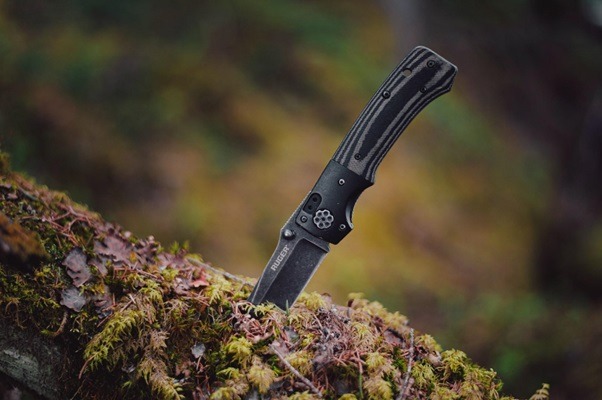If you are a regular camper, hiker, trekker, or just enjoy spending a lot of time outdoors, a survival knife is essential. A great survival knife should be able to serve its intended purpose. You can use a survival knife for:
- Cutting and chopping
- Hunting and cleaning game
- Defending yourself
- Building shelter
- Starting a fire
Types of Survival Knives
All knives are categorized as either fixed blade knives or folding knives.
Fixed Blade Knife
A fixed blade knife does not fold or have any moving parts. Such knives are durable and have a variety of applications, including hunting, cutting, combat, bushcraft, and camping. Because they lack movable parts, they are quite durable.
Fixed blade knives are very easy to maintain and easy to handle. If you are a newbie looking for an EDC, this knife is the one for you. For example, the Schrade SCHF9 knife is a commonly used survival knife with multiple uses. You can read more about Schrade SCHF9 knife on this site.
There are different types of fixed blade knives.
- Boot knives. As the name suggests, boot knives are self-defense knives stored in a boot. It is a non-folding blade that is easy to carry and conceal. One of the best boot knives is the Smith & Wesson HRT Fixed Blade Knife. It has a dual-edged, carbon stainless steel blade with a rubber handle.
- Bowie knives. A bowie knife is named after Jim Bowie, who popularized it during the Sandbar Fight, where he used it to fight off his enemies after being shot. It is characterized by a clipped edge and a long blade.
- Pesh-Kabz. This is a Persian knife designed with a long curved blade that can pierce armor. The blade is flat, except at the tip, which is thicker, making it ideal for combat.
- Dirk. This Scottish weapon was purely designed in the 1600s for combat, which is noticeable in its thin blades. It is larger than the standard pocket knife, and is usually single-edged, though you may find some that are double-edged. They are very versatile and therefore favored by many soldiers.
Folding Knife
Also known as pocket knives, or jack knives folding knives are blades that can be folded, making them easy to carry. They are versatile and can be used for everything, including hunting, opening envelopes, self-defense, and camping. Pocket knives are differentiated according to:
- Type of blade. A folding knife blade can have a clip point, a drop point, or pen blade.
- Knife edge. Pocket knives can come with plain edges, fully serrated edges, or partially serrated ones.
- The number of blades. Folding or pocket knives come with single or multi-blades. Single blades have only one blade that can lock for efficient use, while multi-blades usually have two or more blades, making them ideal for a variety of uses.
Furthermore, some knives come with other tools such as scissors, nail files, and even a corkscrew, like the swiss army knife are important EDC knives.
Hybrid blades
Some knives can come as both fixed blades or folding knives. Such knives include:
- Karambit. Though once an agricultural knife, the karambit has weaved its way into a combat knife usually used in closed quatres.
- Push dagger. Also known as a knuckle knife, This survival knife shaped in a T is made to be grasped between the fingers, precisely the middle and ring fingers. Even though this knife is usually considered a fixed blade, you will find some that fold halfway.
- Kukri. Just like the karambit, this knife was first used for agricultural purposes, specifically in harvesting. It gained popularity in the 1800s as a fighting knife. Though it may appear similar to the bowie knife, the kukri is larger and curvier.
- Neck knife. A neck knife is a light, compact and sturdy knife. It is so-called because it is worn around the neck on a cord or chain. This short and slim knife is put in a sheath and held in place by a strap, loop, or clip. They are favored because they are uncomfortable to carry around.
Tactical/Combat Knife
A tactical knife is a survival knife specifically designed for use in self-defense and armed conflict by military, police, and special forces. A tactical knife has certain specifications that set it apart from other knives.
A tactical knife should be sturdy enough for it to withstand heavy impact. Some tactical knives fall in the category of both folding and fixed knives. Its main features include:
- A non-reflective blade. Some of the best tactical knives have a black coating for camouflage.
- An ergonomic grip. You should be able to have a perfect grip on your tactical knife.
- A centered balanced. Your knife should not be too light or too heavy in weight.
- A pointed blade.
Though some are utility knives, some are specifically designed for this use, such as the boot knife, dirk, push dagger, and pesh-kabz. Whether or not you need a tactical knife solely depends on your outdoor activities.
However, most knives have tactical features. So, you may not necessarily need a tactical knife, particularly if you already have another survival knife.
Conclusion
Most knives meant for utility use, with a 2.5 to 3 inches blade are legal everywhere. However, before carrying any knife, you ensure you understand the state knife laws. In addition, safety comes first, and you should always carry your knife in a sheath.

